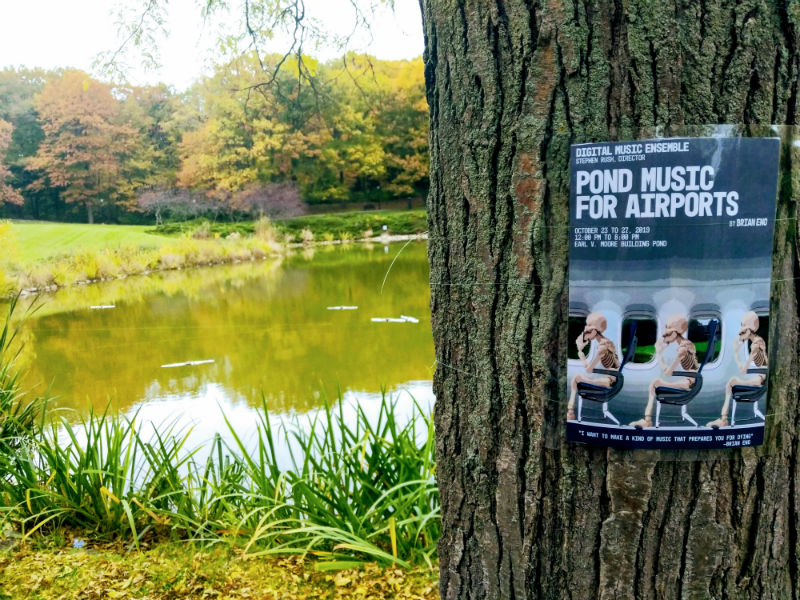The U-M Digital Music Ensemble's "Pond Music for Airports" encountered unexpected turbulence

I went to the pond not to fish, not to swim, but to listen to experimental music.
And all I heard was silence.
It's not because the University of Michigan's Digital Music Ensemble (DME) was performing John Cage's 4'33". The group, under the guidance of Professor Stephen Rush, had worked up a piece inspired by Brian Eno's Music for Airports, the landmark 1978 ambient record that was built by having pre-recorded tape loops of varying lengths go in and out of phase with each another.
The DME's Pond Music XVII: Brian Eno’s Music for Airports -- or more colloquially on the promo posters, Pond Music for Airports -- was created by students who wrote and performed the short music segments that were then committed to tape. The DME artists then spliced the tapes and loaded them onto old reel-to-reel machines, which were set up in front of the retention pond behind the Earl V. Moore Building, which is the home of the U-M School of Music, Theatre & Dance, located on North Campus.

The pond was outfitted with small airplane propellers, tied together with wire so they wouldn't blow to shore, and they were meant to spin, creating a symbiotic visual with the twirling tape reels, set against the backdrop of trees filled with color-changing leaves that surround the water.
The whole installation was scheduled to run October 24-27, with an estimated 40 hours of playback, as students supervised their creation in shifts.
But an uncomfortable incident on the opening day -- related to me off the record -- led the DME to bring the tape portion of Pond Music for Airports inside the Moore building on October 25, which ended up being the last day of the installation.
In addition to the confrontation -- initiated by someone not involved with the project -- marring the positive energy surrounding the work's debut, by the end of day two the tapes began to disintegrate. Not the actual substance of the tapes, but the numerous splices that were implemented to create the work. The splices had started to get fragile and separate.
The students had enough.

When I entered the Moore building around 4 pm on October 25, I saw the last few minutes of Pond Music for Airports, its lovely, interlocked melodies and textures filling the lobby just inside the structure's main entrance. But soon after, the students switched off the machines and began collecting the tape, bringing the project to an early end.
There's talk that the students might upload the various musical clips that make up Pond Music for Airports to a website, which would allow a digital version of their phasing composition to exist in perpetuity. Listeners would be able to play with various controls to put their own spin on this generative music piece, offering endless variations on the composition's simple themes.
I hope this happens because the students deserve to have their work heard, even if it's not in its original setting.
For now, if you walk past the pond behind the Moore building, play Eno's Music for Airports in your headphones as you gaze at the still propellers and up into the trees, and imagine what should've been.
Christopher Porter is a library technician and the editor of Pulp.
Related: "DME to channel Eno’s ‘Music for Airports'" [The Michigan Daily, October 21, 2019]


































